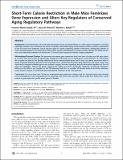| dc.contributor.author | Estep, Preston Wayne | |
| dc.contributor.author | Warner, Jason B. | |
| dc.contributor.author | Bulyk, Martha Leonia | |
| dc.date.accessioned | 2011-04-29T01:25:37Z | |
| dc.date.issued | 2009 | |
| dc.identifier.citation | Estep, Preston Wayne, Jason B. Warner, and Martha L. Bulyk. 2009. Short-Term Calorie Restriction in Male Mice Feminizes Gene Expression and Alters Key Regulators of Conserved Aging Regulatory Pathways. PLoS ONE 4(4): e5242. | en_US |
| dc.identifier.issn | 1932-6203 | en_US |
| dc.identifier.uri | http://nrs.harvard.edu/urn-3:HUL.InstRepos:4879193 | |
| dc.description.abstract | Background: Calorie restriction (CR) is the only intervention known to extend lifespan in a wide range of organisms, including mammals. However, the mechanisms by which it regulates mammalian aging remain largely unknown, and the involvement of the TOR and sirtuin pathways (which regulate aging in simpler organisms) remain controversial. Additionally, females of most mammals appear to live longer than males within species; and, although it remains unclear whether this holds true for mice, the relationship between sex-biased and CR-induced gene expression remains largely unexplored. Methodology/Principal Findings: We generated microarray gene expression data from livers of male mice fed high calorie or CR diets, and we find that CR significantly changes the expression of over 3,000 genes, many between 10- and 50-fold. We compare our data to the GenAge database of known aging-related genes and to prior microarray expression data of genes expressed differently between male and female mice. CR generally feminizes gene expression and many of the most significantly changed individual genes are involved in aging, hormone signaling, and p53-associated regulation of the cell cycle and apoptosis. Among the genes showing the largest and most statistically significant CR-induced expression differences are Ddit4, a key regulator of the TOR pathway, and Nnmt, a regulator of lifespan linked to the sirtuin pathway. Using western analysis we confirmed post-translational inhibition of the TOR pathway. Conclusions: Our data show that CR induces widespread gene expression changes and acts through highly evolutionarily conserved pathways, from microorganisms to mammals, and that its life-extension effects might arise partly from a shift toward a gene expression profile more typical of females. | en_US |
| dc.language.iso | en_US | en_US |
| dc.publisher | Public Library of Science | en_US |
| dc.relation.isversionof | doi:10.1371/journal.pone.0005242 | en_US |
| dc.relation.hasversion | http://www.ncbi.nlm.nih.gov/pmc/articles/PMC2667255/pdf/ | en_US |
| dash.license | LAA | |
| dc.subject | nutrition | en_US |
| dc.subject | genetics and genomics | en_US |
| dc.subject | functional genomics | en_US |
| dc.subject | gene expression | en_US |
| dc.subject | physiogenomics | en_US |
| dc.title | Short-Term Calorie Restriction in Male Mice Feminizes Gene Expression and Alters Key Regulators of Conserved Aging Regulatory Pathways | en_US |
| dc.type | Journal Article | en_US |
| dc.description.version | Version of Record | en_US |
| dc.relation.journal | PLoS ONE | en_US |
| dash.depositing.author | Bulyk, Martha Leonia | |
| dc.date.available | 2011-04-29T01:25:37Z | |
| dash.affiliation.other | HMS^Orthopedic Surgery-Mass General Hospital | en_US |
| dash.affiliation.other | HMS^Pathology | en_US |
| dash.affiliation.other | HMS^Medicine-Brigham and Women's Hospital | en_US |
| dc.identifier.doi | 10.1371/journal.pone.0005242 | * |
| dash.contributor.affiliated | Bulyk, Martha | |


